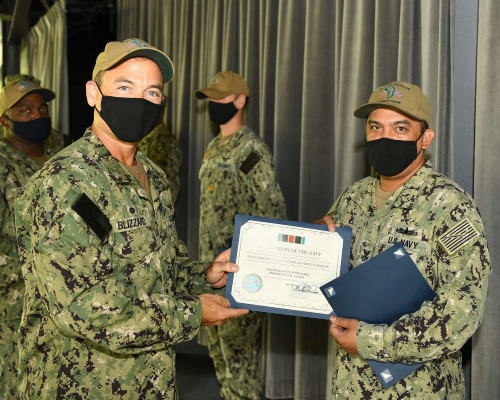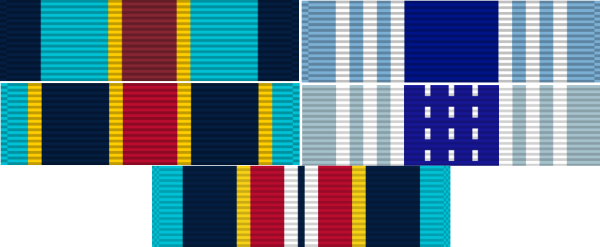The Overseas Service Ribbon has an important place on the uniform of every branch of the U.S. Armed Forces.
It represents, as the name implies, the completion of overseas duty of military service.
Therefore, recipients are awarded a military ribbon to designate duty outside the borders of the United States.
Learn more about the Overseas Service Ribbon, including the history and service branches that recognize the award.
Related Article – Army Achievement Medal (AAM): 6 Things To Know
Table of Contents
Overseas Service Ribbon Explained

It’s not uncommon for military service to include duty assignments outside the continental United States.
Overseas service requires additional dedication and sacrifice, considering that military personnel are away from families for an extensive period of time.
Moreover, overseas duty often involves service in dangerous areas of conflict or less-than-ideal conditions.
For this reason, the U.S. Armed Forces recognize overseas service with a military ribbon.
The name and appearance of the service ribbon vary, depending on the military branch:
- U.S. Army Overseas Service Ribbon
- Navy & Marine Corps Overseas Service Ribbon
- Air & Space Force Overseas Service Ribbon
- Coast Guard Overseas Service Ribbon
- Army Reserve Overseas Training Ribbon
Learn more about the history of the Overseas Service Ribbon, including details of the award presented to each service branch, below:
History
The military award is presented to members of the U.S. Air Force, Army, Coast Guard, Marine Corps, Navy, and Space Force.
The United States Army was the first service branch to issue an Overseas Service Ribbon in 1981.
Meanwhile, the Army Reserve component of the award was established a few years later (1984).
The Navy and Marine Corps combined the Overseas Service Ribbon into one award, which was first granted to service members in 1986.
Likewise, the United States Air Force and Coast Guard combine their version of the Overseas Service Ribbon into a single ribbon.
The Air and Space Force Overseas Service Ribbon was established in 1980 while the Coast Guard variant was recently approved in 2009.
Now, for an individual breakdown of each service ribbon.
Related Article – Army Service Ribbon (ASR): 5 Things To Know
Army Overseas Service Ribbon

The Army was the first military branch to create an Overseas Service Ribbon.
As such, the service branch began issuing the ribbon in August of 1981.
The award, like the other military ribbons on this list, is reserved for those who complete overseas service.
In general, each service branch has its own determination including eligibility requirements to receive the ribbon.
For example, in the U.S. Army, the length of an eligible overseas tour depends on A) the location and B) whether or not the soldier was accompanied by a spouse or other family members.
Additionally, the United States Army presents two different versions:
- Short Tour: 6-23 months overseas duty.
- Long Tour: 24+ months overseas duty.
The Army considers any service shorter than 6 months TDY (Temporary Duty Assignment), and therefore not eligible for the award.
Furthermore, the location of the overseas duty assignment factors into the length of time required for eligibility.
The military branch denotes additional honors on the ribbon with award numerals.
Furthermore, those who served in designated combat zones earn Overseas Service Bar(s).
The military award is presented retroactively to soldiers under certain circumstances.
Army Reserve Overseas Award
The Army Reserve features its own variant of the overseas ribbon.
It’s known as the Army Reserve Components Overseas Training Ribbon (ARCOTR).
The military award was established in 1984 and recognizes those who complete annual training or ADT for 10+ consecutive days on foreign soil.
Moreover, all ARNG and USAR soldiers that accompany an Army Reserve Component (RC) unit are also eligible.
It’s worth noting that while other service branches acknowledge reservists, the Army Reserve and National Guard are the only components that recognize overseas training.
Related Article – US Marine Corps Ribbons Explained
Air & Space Force Overseas Service Ribbon

The Air Force Overseas Service Ribbon (ASOR) was authorized in 1980.
In 2020, the title was changed to the “Air and Space Overseas Service Ribbon” to accommodate the recently established U.S. Space Force.
The military award is presented in two different grades, like the Army version of the ribbon:
- Air & Space Overseas Short Tour: Less than 2 years of service.
- Air & Space Overseas Long Tour: More than 2 years of service.
In general, the basic requirement is that the permanent duty assignment last at least 300 days within an 18-month period.
The Air Force grants additional awards represented by oak leaf clusters.
Additionally, the service branch authorizes a recipient of both the short and long-tour awards to wear the ribbons simultaneously on the uniform.
Lastly, an “A” device on the short tour ribbon denotes a tour of duty at an Arctic Air Force or Space Force facility.
The appearance of the Air and Space Overseas Service Ribbon is substantially different from the Army ribbon.
Related Article – Air Force Ribbons Explained
Coast Guard Overseas Service Ribbon

The United States Coast Guard recently adopted its own version of the service ribbon.
There is no division between short and long tour duty, like the Army and Air and Space Force variants.
As such, the Coast Guard Overseas Service Ribbon is provided to any Coastie who completes a tour of duty of at least 12 months.
Furthermore, Coast Guard reservists are also eligible for the award after completing a minimum of 36 cumulative days of service in a 12-month period.
However, duty on board U.S. deploying ships or units does not qualify for the military award.
Additionally, Coasties that are eligible for the Restricted Duty Ribbon cannot receive this ribbon for the same duty timeframe.
Lastly, the service ribbon is awarded retroactively to qualifying Guardsmen.
Those who earn subsequent awards display small bronze or silver service stars on the ribbon.
Related Article – Coast Guard Ribbons Explained
Navy & Marine Corps Overseas Service Ribbon

The Marine Corps and Navy are interchangeable in many regards, including the sharing of this ribbon.
The Navy and Marine Corps version of the military award has been proposed since the late 1960s.
However, it was not until 1986 that the service ribbon was established with the service branches.
Those who are eligible for the award must complete 1 year of consecutive or cumulative duty at a permanent overseas duty station.
Additionally, personnel of the Navy Reserve are eligible after completing either A) 30 consecutive or B) 45 cumulative days of overseas duty.
Moreover, in 1999, the U.S. Navy added personnel stationed on overseas homeported naval vessels to also qualify for the award.
Today, military personnel are authorized to receive both the OSR award and the Sea Service Deployment Ribbon (SSDR) for the same tour of duty.
Marines and sailors are recognized with additional awards by service stars displayed on the uniform.
Related Article – US Navy Ribbons Explained
Conclusion
There are numerous sacrifices that military personnel make throughout their journey.
Often, service members are called for duty overseas, sometimes in dangerous or combative regions.
Accordingly, the U.S. Armed Forces recognize overseas service with a military decoration.
For this reason, a service ribbon is granted to recipients of the award.
The appearance of the ribbon varies depending on the military branch.
The same is true of the eligibility requirements.
- Ikon Pass Military Discount: Learn How To Save Big - January 31, 2025
- RTIC Military Discount: Find Out How To Save Big on Gear - January 30, 2025
- Traeger Military Discount: Learn How To Save Big on Smokers - January 28, 2025


